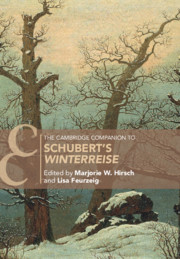Music Examples
11.1(a) “Walking” rhythm and F–E motif in “Gute Nacht,” mm. 1–3; (b) “walking” rhythm in “Einsamkeit,” mm. 1–3; (c) “rushing wind” and F–E motif in “Die Wetterfahne,” mm. 1–4; (d) “rushing wind” in “Rückblick,” mm. 1–2; (e) slow, arrested rhythm in “Wasserflut,” mm. 1–2; (f) “lulling” rhythm in “Frühlingstraum,” mm. 1–2
11.2(a) C–B motif in “Der Lindenbaum,” m. 26; (b) and in “Der Leiermann,” m. 4; (c) E–F sorrowful climax in “Wasserflut,” m. 12; (d) F–E motif and I–II42–I progression in “Gute Nacht,” mm. 8–10; (e) II♯
 –I6 progression in “Die Wetterfahne,” mm. 31–32; (f) apparent I–V–IV–I regression in “Irrlicht,” mm. 1–2; (g) and in mm. 5–6
–I6 progression in “Die Wetterfahne,” mm. 31–32; (f) apparent I–V–IV–I regression in “Irrlicht,” mm. 1–2; (g) and in mm. 5–611.3(a) Recitative passage in “Die Wetterfahne,” mm. 11–13; (b) dissonant intervals, mm. 15–17; (c) unisons between piano and voice, mm. 6–9; (d) chorale-like texture in “Im Dorfe,” mm. 37–39; (e) distant, rapid harmonic changes in “Auf dem Flusse,” mm. 8–9; (f) and in “Der greise Kopf,” mm. 10–12; (g) vocal outburst in the higher register in “Gefror’ne Tränen,” mm. 47–49; (h) rapid melisma in “Die Wetterfahne,” mm. 17–18
11.4(a) Dotted rhythms in “Wasserflut,” mm. 5–7; (b) 5‸–8‸ motion, mm. 11–12; (c) and in mm. 13–14; (d) piano accompaniment overpowering the voice in “Einsamkeit,” mm. 28–30; (e) modulation to ♭II over a dominant pedal point and return to V of the main key in “Gefror’ne Tränen,” mm. 34–38; (f) and in “Einsamkeit,” mm. 30–34
12.2“Frühlingstraum”: Disruptive rests in piano accompaniment

